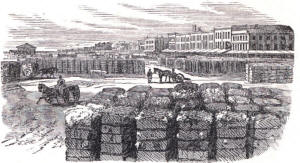General McClellan did not think the plan feasible, for it would take 50,000 men, and he was unwilling to spare a man from his army of more than 200,000 men lying around Washington.
President Lincoln approved of the project, and
Mr. Stanton said to General Butler, " The man who takes New Orleans shall be made a lieutenant-general." Butler called for troops. New England was alive with enthusiasm and furnished them, in addition to her thousands in the
Army of the Potomac. He sailed from
Fort Monroe, Feb. 25, 1862, with his wife, his staff, and 1,400 New England troops. Storms and delays made the passage long, and it was thirty days before he landed on dreary Ship Island (his place of destination), off the coast of Mississippi, where there was an unfinished fort. The Confederates of that region had taken possession of that island and the fort in considerable force. During their occupation of it for about four months, they made it strong and available for defense. They constructed eleven bomb-proof casemates, a magazine and barracks, mounted twenty heavy
Dahlgren guns, and named it Fort Twiggs. When a rumor that a strong naval force was approaching reached the island, the Confederate garrison abandoned the fort, burned the barracks, and with their
cannon fled to the mainland. On the following day, a small force was landed from the National gunboat Massachusetts, and took possession of the place. They strengthened the fort by building two more casemates, adding
Dahlgren and rifled cannon, and piling around its outer walls tiers of sand bags six feet in depth. They gave to the fort the name of their vessel, and it became Fort Massachusetts. When General Butler arrived, there was no house on the island, and it was with much difficulty that a decent place of shelter was prepared for his wife and his military family. General Phelps was there with New England troops, so also were
Commodore Farragut with a naval force, and
COMMODORE D. D. PORTER with a fleet of bomb-vessels to cooperate with the land force. At a short bend in the Mississippi River, 60 miles below New Orleans, were Forts Jackson and St. Philip. These, with some fortifications above and obstructions in the river below, were believed by the Confederates to make the stream absolutely impassable by vessels. There were then 10000 troops in New Orleans hinder
Gen. Mansfield Lovell. One of the New Orleans journals said, in a boastful manner, "Our only fear is that the Northern invaders might not appear. We have made such extensive preparations to receive them, that it were vexatious if their invincible armada escapes the fate we have in store for it." On April 28 the fleets of
Farragut and
Porter were within the Mississippi River, the former in chief command of the naval forces; and General Butler, with about 9,000 troops. was at the Southwest Pass. The fleets comprised forty-seven armed vessels, and these, with the transports, went up the river, Porter's mortar-boats leading. When they approached the forts their hulls were besmeared with mud, and the rigging was covered with branches of trees. So disguised, they were enabled to take a position near the forts unsuspected. The Mississippi was full to the brim, and a boom and other obstructions near Fort Jackson had been swept away by the flood. On April 18 a battle between Fort Jackson and Porter's mortar-boats was begun. The gunboats supported the mortar-boats. They could not much affect the forts, and on the night of the 23d the fleet started to run by them, the mortar-boats helping. The perilous passage of the forts was begun at 2 A.M. The night was intensely dark, and in the gloom a tremendous battle was waged. The National naval force was met by a Confederate one. In that struggle the Nationals were victorious. While the battle was raging near the forts, General Butler landed his troops, and in small boats passed through narrow and shallow bayous in the rear of Fort St. Philip. The alarmed garrison surrendered to Butler without resistance, declaring they had been pressed into the service and would fight no more. When the forts were surrendered and the Confederate gunboats subdued,
Farragut rendezvoused at Quarantine, and then with nine vessels went up to New Orleans. There a fearful panic prevailed, for the people had heard of the disasters below. Drums were beating, soldiers were hurrying to and fro, cotton was carried to the levee to be burned; funds in the amount of $4,000,000 had been carried away from the banks, and citizens, with millions in property, had fled from the city. When Farragut approached (April 23), General Lovell and his troops fled: the torch was applied to the cotton on the levee, and 15,000 bales, a dozen large ships, and as many fine steamers, with unfinished gunboats and other large vessels, were destroyed in the conflagration. The citizens were held in durance by Farragut's guns until the arrival of Butler on May 1, when the latter landed with his troops, took formal possession of the defenseless town, and made his headquarters at the
St. Charles Hotel. The loss of New Orleans was a terrible blow to the Confederates. From Harper's Brother's American History Volume VI. |
